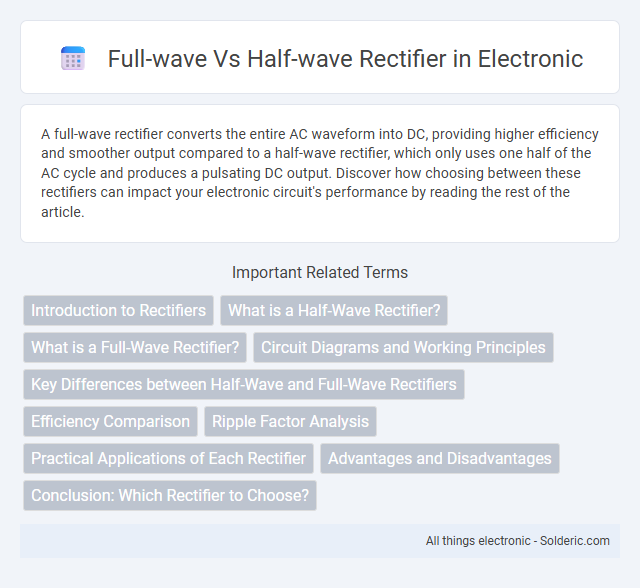A full-wave rectifier converts the entire AC waveform into DC, providing higher efficiency and smoother output compared to a half-wave rectifier, which only uses one half of the AC cycle and produces a pulsating DC output. Discover how choosing between these rectifiers can impact your electronic circuit's performance by reading the rest of the article.
Comparison Table
| Feature | Full-Wave Rectifier | Half-Wave Rectifier |
|---|---|---|
| Output Voltage | Higher average output voltage | Lower average output voltage |
| Rectification Efficiency | About 81.2% | About 40.6% |
| Ripple Frequency | Twice the input AC frequency | Same as input AC frequency |
| Transformer Usage | Requires center-tap transformer or bridge circuit | No center-tap transformer needed |
| Complexity | More complex circuit with multiple diodes | Simple circuit with one diode |
| Current Flow | Conducts during both half-cycles | Conducts during one half-cycle only |
| Use Case | Preferred for DC power supplies requiring smooth output | Used for low power, simple applications |
Introduction to Rectifiers
Rectifiers convert alternating current (AC) to direct current (DC) for electronic devices. Full-wave rectifiers utilize both halves of the AC cycle, providing higher output voltage and efficiency compared to half-wave rectifiers which use only one half-cycle. Full-wave rectifiers reduce ripple frequency, improving voltage regulation and performance in power supply applications.
What is a Half-Wave Rectifier?
A half-wave rectifier is an electronic circuit that converts alternating current (AC) into pulsating direct current (DC) by allowing only one half-cycle of the AC waveform to pass through while blocking the other half. It uses a single diode to conduct current during the positive half of the input AC signal and blocks current during the negative half, resulting in a unidirectional output. This simple design leads to lower efficiency and higher ripple compared to a full-wave rectifier, which utilizes both halves of the AC cycle for smoother DC output.
What is a Full-Wave Rectifier?
A full-wave rectifier converts the entire input AC signal into a pulsating DC output by using both halves of the AC cycle. It employs either a center-tapped transformer with two diodes or a bridge configuration with four diodes, resulting in higher efficiency and reduced ripple compared to a half-wave rectifier. This design provides better output voltage, improved power delivery, and smoother DC output for electronic devices.
Circuit Diagrams and Working Principles
A full-wave rectifier circuit consists of four diodes arranged in a bridge configuration or utilizes a center-tapped transformer with two diodes, enabling it to convert both halves of the AC input waveform into positive output voltage. In contrast, a half-wave rectifier employs a single diode that allows current flow only during the positive half-cycle of the AC input, resulting in pulsating DC output with larger gaps between pulses. The full-wave rectifier's operation produces a smoother and more continuous DC output by rectifying both halves of the input signal, whereas the half-wave rectifier provides output only for one half-cycle, causing greater ripple and lower efficiency.
Key Differences between Half-Wave and Full-Wave Rectifiers
Half-wave rectifiers convert only one half-cycle of the AC input signal into DC, resulting in lower efficiency and higher ripple voltage compared to full-wave rectifiers, which utilize both half-cycles for rectification. Full-wave rectifiers offer improved output smoothness and higher average output voltage due to continuous conduction through both halves of the waveform, whereas half-wave rectifiers produce pulsating DC with longer intervals of zero current. The full-wave design employs either a center-tapped transformer or a bridge configuration, enhancing power efficiency and reducing ripple, whereas half-wave rectifiers feature a simpler circuit with a single diode.
Efficiency Comparison
Full-wave rectifiers exhibit higher efficiency compared to half-wave rectifiers because they utilize both halves of the AC waveform, resulting in a greater average output voltage and reduced ripple. The efficiency of a full-wave rectifier typically approaches 81%, whereas a half-wave rectifier's efficiency usually peaks around 40.6%. This significant difference makes full-wave rectifiers more suitable for applications requiring stable DC output and improved power conversion.
Ripple Factor Analysis
Full-wave rectifiers exhibit a significantly lower ripple factor compared to half-wave rectifiers, resulting in smoother DC output and improved voltage regulation for your electronic circuits. The ripple factor of a full-wave rectifier is approximately 0.482, nearly half that of a half-wave rectifier, which has a ripple factor close to 1.21, indicating less ripple and enhanced efficiency in power supply applications.
Practical Applications of Each Rectifier
Full-wave rectifiers are commonly used in power supply circuits that require efficient conversion of AC to DC, such as in battery chargers, DC motor drives, and regulated power supplies due to their higher output voltage and smoother waveform. Half-wave rectifiers are typically found in low-power applications like signal demodulation and simple power supplies where cost and simplicity are prioritized over efficiency. Understanding your application's power requirements will help determine whether a full-wave or half-wave rectifier is more suitable.
Advantages and Disadvantages
A full-wave rectifier offers higher efficiency and smoother output voltage compared to a half-wave rectifier, as it converts both halves of the AC signal into DC, reducing ripple frequency to twice the input frequency and improving transformer utilization. However, full-wave rectifiers require more complex circuitry and additional diodes, increasing cost and size, whereas half-wave rectifiers are simpler, cheaper, and easier to implement but generate higher ripple voltage and lower average output voltage, leading to less efficient power conversion. The choice between full-wave and half-wave rectifiers depends on the application's power quality requirements and cost constraints.
Conclusion: Which Rectifier to Choose?
Full-wave rectifiers provide higher efficiency and smoother DC output by utilizing both halves of the AC signal, making them ideal for applications requiring stable voltage and reduced ripple. Half-wave rectifiers are simpler and cheaper but less efficient, suitable for low-power or low-cost devices where performance is less critical. Your choice depends on balancing cost, efficiency, and output quality for the specific electronic application.
full-wave vs half-wave rectifier Infographic

 solderic.com
solderic.com